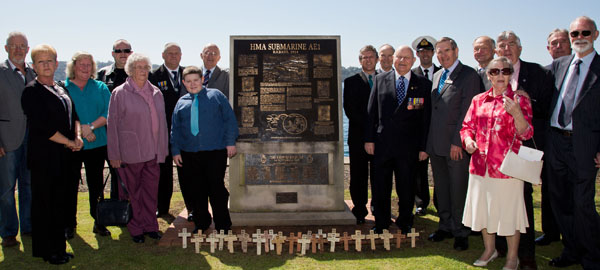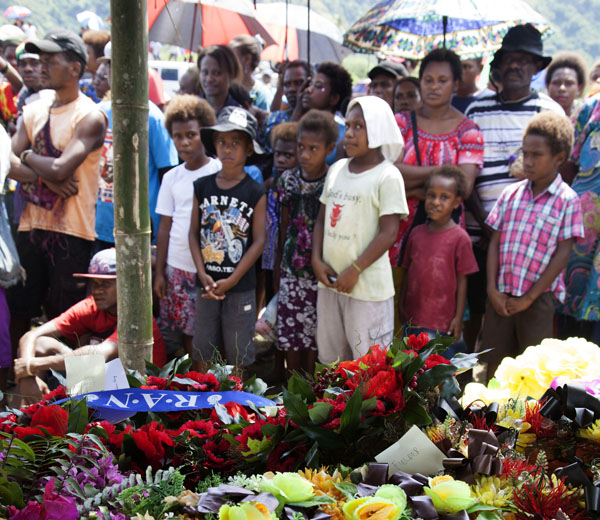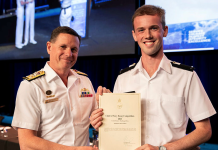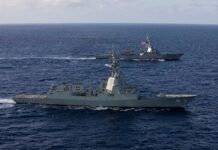
The service was conducted in the RAN Memorial Chapel, Garden Island, in the presence of the Governor General His Excellency General the Honourable Sir Peter Cosgrove AK MC, and Governor of New South Wales Her Excellency Professor the Honourable Dame Marie Bashir AD CVO, in the uniform of Honorary Commodore RAN; parliamentary representatives and descendants of the crew of AE1.
Wreathes were laid at the AE1 memorial window by those above and also by the Honourable Mr Malcolm Turnbull on behalf of the Government; Mr David Feeney on behalf of the opposition, and LCDR Jonathan Bannister, RN on behalf of the British Government and the Royal Navy. Mr Turnbull read a message from the Prime Minister. Also present were descendants of the crew including those who had flown in for the event from Canada. The names of those lost were read out by the Submarine Force Commander, CAPT Matthew Buckley RAN, and Dr Michael White the President of the AE1 Association. Thirty-five crosses were placed in the lawn in front of the AE1 memorial on Garden Island.

The speech was also given in very similar form by the Deputy Submarine Force Commander, Commander Neil Carson RAN, Deputy Commander, Australian Submarine Force, at the HMAS Stirling Commemoration Service, in the presence of Mr Joe Francis MLA, Minister for Emergency Services; Corrective Services; Small Business; and Veterans, and Captain Angela Bond RAN, CO HMAS Stirling, at the HMAS Stirling Commemoration Service.
Ladies and Gentlemen
“A ship is safe in harbour, but that is not what ships are built for.” These words were popularised by an American Admiral of the computer age, Grace M. Hopper. But they are ageless in their meaning.
For all ships, and warships in particular, harbours are places of relative safety. But warships are not built for safety.
They are built to go in harms way, to take risks and to fight and win at sea. They must endure not only the actions of the enemy, but also the power and fury of the seas.
The crew of Australia’s first submarines were keenly aware of the risks of their profession.
In May of 1914 at a public reception to mark their arrival in Sydney the commanding officer of AE1, Lieutenant Commander Thomas Besant, spoke about life as a submariner. He said:
“It’s not all beer and skittles and perhaps it is a harder life than in other branches of the service, but it’s the life I’ve chosen. Oh, yes, it’s dangerous if you want to look at it like that but it’s got to be done – and every man in the Navy, no matter what branch he is in, has to be prepared to meet danger when it comes.”
Ladies and Gentlemen, we meet today in Rabaul and in Sydney to remember the 35 men who were the crew of our first submarine, HMAS AE1, and who died on this day in September a century ago.
In an age when we circle the globe in a day, and when we know much more about submarines and the undersea environment they inhabit, it is difficult to truly appreciate the magnitude of the cool, calm courage these crews needed just to take these boats to sea, let alone to war.
They died in the first RAN vessel to be lost at sea and have a particular and permanent place in the nation’s naval history. For their professional descendants the bravery of the men of AE1 and AE2 remains the gold standard for the RAN’s submarine service.
The circumstances of AE1’s loss have always been both tragic and mysterious. Though we hope one day to find their final resting place, we may never know exactly why and how AE1 sank.
That sense of the unknown should do nothing to diminish our admiration for the crew.
While the scale of the casualties during the First World War can tempt us to skip over the smaller actions and the little numbers, this is a temptation we must resist.
Each person who served risked their life. Each person who died or was injured had family and friends. Each of them gave of themselves for the security, prosperity and way of life we enjoy today.
Their fate did not slip from the minds of their families in Australia and Britain and in New Zealand whose mourning for them was life long.
Indeed the Australian National Maritime Museum’s upcoming exhibition on the Navy in the First World War opens a very moving and insightful window on the human impact of the war.)
The fate of AE1 and AE2 has not slipped from the memory of the Royal Australian Navy.
Two new vessels will be named Stoker and Bessant in honour not just of the commanding officers, but of all members of both crews.
And our modern submarine force continues to take inspiration from the efforts and success of our first submariners – deploying over huge distances and operating forward.
Today our submarines are Australia’s primary strategic deterrent.
They provide the Government with options to take action in our in our national interest, at a time of their choosing and under any conceivable threat scenario.
They possess the strategic weight to shape and change the behaviour of other nations and the calculus of their leaders.
They are an offensive capability, intended to sink ships and other submarines. Simply put, it is this capacity for destruction that can so powerfully deter a potential adversary and makes such a significant contribution towards our national defence and regional maritime security.
For a maritime nation such as Australia our submarines are essential to our security, our prosperity and our way of life.
And even though our submarines today are hugely more capable than their predecessors, their crucial edge is found in their people – the crews who take them to sea and the people who support and maintain them – everyone who animates our submarine enterprise.
They all know that our submarines are safe in harbour, but that is not what they are built for.
So as we remember the service and sacrifice of the crew of AE1, I can do not better than quote one of the crew of the AE2, Able Seaman John Wheat, who wrote a heartfelt dedication to AE1 in tribute to his fellow submariners.
To the memory of our sister ship AE1 and her crew. We took the first patrol on the 13th, they took the second next day. We came back, they didn’t. The path of our duty became the highway of mystery for them for they never returned. They lie coffined in the deep, keeping their silent watch at Australia’s North Passage, heroes all.



